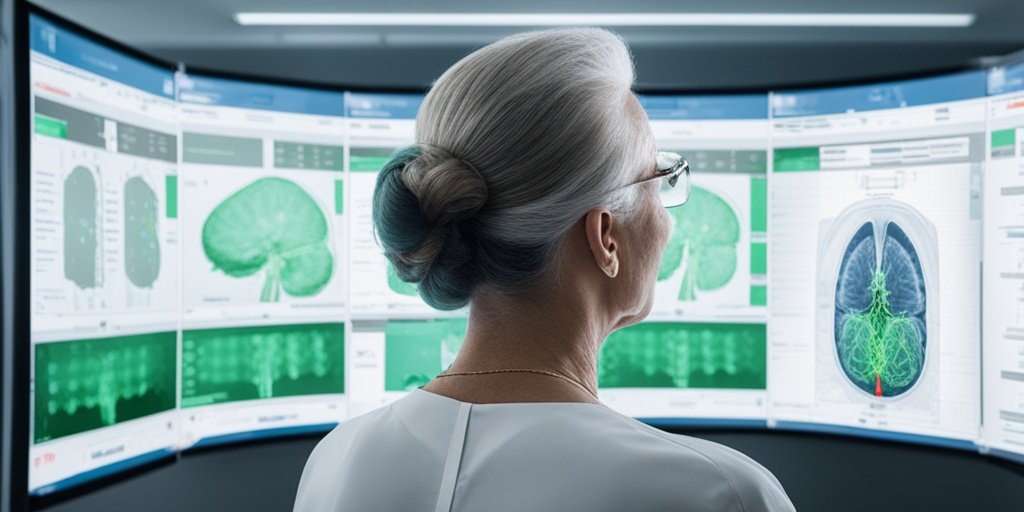⚡ Quick Summary
This study developed morphological and radiomic models to predict cognitive impairment associated with cerebrovascular disease (CI-CVD) in elderly individuals using cerebral magnetic resonance angiography (MRA). The combined model achieved an impressive AUC of 0.883 in the training set, highlighting its potential for early diagnosis.
🔍 Key Details
- 📊 Dataset: 104 patients with CI-CVD and 107 control subjects
- 🧩 Features used: Morphological features and radiomic features
- ⚙️ Technology: Automated quantitative analysis and LASSO regression
- 🏆 Performance: AUC of 0.883 in training set, 0.843 in external testing set
🔑 Key Takeaways
- 🧠 Cognitive impairment is a significant concern in the elderly, particularly related to cerebrovascular disease.
- 📈 The study identified a history of stroke as a critical clinical risk factor (OR 2.796).
- 🔍 Morphological indicators such as stenosis in cerebral arteries were linked to cognitive impairment.
- 📊 The multipredictor model combined clinical, morphological, and radiomic features for enhanced predictive performance.
- 🌟 Radiomic features provided additional insights into the risk factors for CI-CVD.
- 🔬 The study emphasizes the importance of early detection and intervention in cognitive decline.
- 🌍 Conducted over 14 years, the research highlights the value of long-term data in understanding cognitive health.
- 🗝️ Key metrics include an AUC of 0.883, indicating strong model performance.

📚 Background
Cognitive impairment associated with cerebrovascular disease (CI-CVD) is a growing concern among the elderly population. Traditional methods of assessing cognitive decline often lack the precision needed for early intervention. This study aims to bridge that gap by utilizing advanced imaging techniques and quantitative analysis to identify risk factors associated with CI-CVD.
🗒️ Study
The research involved a retrospective analysis of data from a 14-year elderly MRA cohort, comprising 104 patients diagnosed with CI-CVD and 107 control subjects. The study employed automated quantitative analysis to evaluate various morphological features of cerebral arteries, while radiomic features were extracted using LASSO regression to enhance predictive capabilities.
📈 Results
The findings revealed that several morphological features, such as stenosis in the right middle cerebral artery (RMCA) and left posterior cerebral artery (LPCA), were significant risk factors for cognitive impairment. The combined clinical-morphological-radiomic model demonstrated optimal performance, achieving an AUC of 0.883 in the training set and 0.843 in the external testing set, indicating its robustness in predicting CI-CVD.
🌍 Impact and Implications
The implications of this study are profound, as it underscores the potential of integrating radiomic and morphological analyses for early detection of cognitive impairment. By identifying critical risk factors, healthcare providers can implement timely interventions, ultimately improving patient outcomes and quality of life for the elderly population. This research paves the way for future studies to explore similar methodologies in other cognitive disorders.
🔮 Conclusion
This study highlights the significant role of radiomics and morphological quantification in predicting cognitive impairment associated with cerebrovascular disease in the elderly. The promising results of the predictive models suggest a new frontier in early diagnosis and intervention strategies. Continued research in this area is essential to refine these models and enhance their applicability in clinical settings.
💬 Your comments
What are your thoughts on the integration of radiomic features in predicting cognitive impairment? We would love to hear your insights! 💬 Share your comments below or connect with us on social media:
Risk prediction for elderly cognitive impairment by radiomic and morphological quantification analysis based on a cerebral MRA imaging cohort.
Abstract
OBJECTIVE: To establish morphological and radiomic models for early prediction of cognitive impairment associated with cerebrovascular disease (CI-CVD) in an elderly cohort based on cerebral magnetic resonance angiography (MRA).
METHODS: One-hundred four patients with CI-CVD and 107 control subjects were retrospectively recruited from the 14-year elderly MRA cohort, and 63 subjects were enrolled for external validation. Automated quantitative analysis was applied to analyse the morphological features, including the stenosis score, length, relative length, twisted angle, and maximum deviation of cerebral arteries. Clinical and morphological risk factors were screened using univariate logistic regression. Radiomic features were extracted via least absolute shrinkage and selection operator (LASSO) regression. The predictive models of CI-CVD were established in the training set and verified in the external testing set.
RESULTS: A history of stroke was demonstrated to be a clinical risk factor (OR 2.796, 1.359-5.751). Stenosis ≥ 50% in the right middle cerebral artery (RMCA) and left posterior cerebral artery (LPCA), maximum deviation of the left internal carotid artery (LICA), and twisted angles of the right internal carotid artery (RICA) and LICA were identified as morphological risk factors, with ORs of 4.522 (1.237-16.523), 2.851 (1.438-5.652), 1.373 (1.136-1.661), 0.981 (0.966-0.997) and 0.976 (0.958-0.994), respectively. Overall, 33 radiomic features were screened as risk factors. The clinical-morphological-radiomic model demonstrated optimal performance, with an AUC of 0.883 (0.838-0.928) in the training set and 0.843 (0.743-0.943) in the external testing set.
CONCLUSION: Radiomics features combined with morphological indicators of cerebral arteries were effective indicators for early signs of CI-CVD in elderly individuals.
KEY POINTS: Question The relationship between morphological features of cerebral arteries and cognitive impairment associated with cerebrovascular disease (CI-CVD) deserves to be explored. Findings The multipredictor model combining with stroke history, vascular morphological indicators and radiomic features of cerebral arteries demonstrated optimal performance for the early warning of CI-CVD. Clinical relevance Stenosis percentage and tortuosity score of the cerebral arteries are important risk factors for cognitive impairment. The radiomic features combined with morphological quantification analysis based on cerebral MRA provide higher predictive performance of CI-CVD.
Author: [‘Xu X’, ‘Zhou Y’, ‘Sun S’, ‘Cui L’, ‘Chen Z’, ‘Guo Y’, ‘Jiang J’, ‘Wang X’, ‘Sun T’, ‘Yang Q’, ‘Wang Y’, ‘Yuan Y’, ‘Fan L’, ‘Yang G’, ‘Cao F’]
Journal: Eur Radiol
Citation: Xu X, et al. Risk prediction for elderly cognitive impairment by radiomic and morphological quantification analysis based on a cerebral MRA imaging cohort. Risk prediction for elderly cognitive impairment by radiomic and morphological quantification analysis based on a cerebral MRA imaging cohort. 2025; (unknown volume):(unknown pages). doi: 10.1007/s00330-024-11336-9